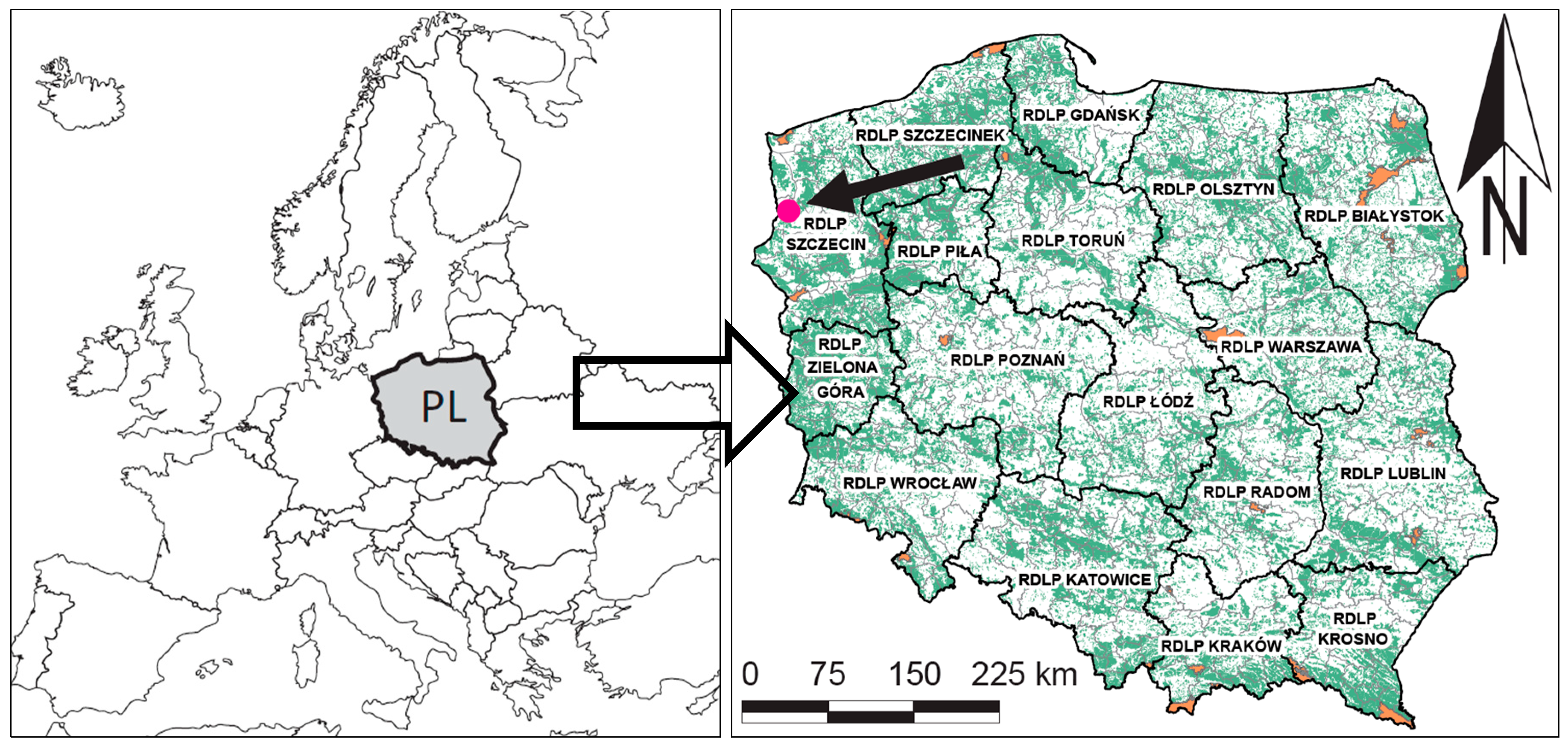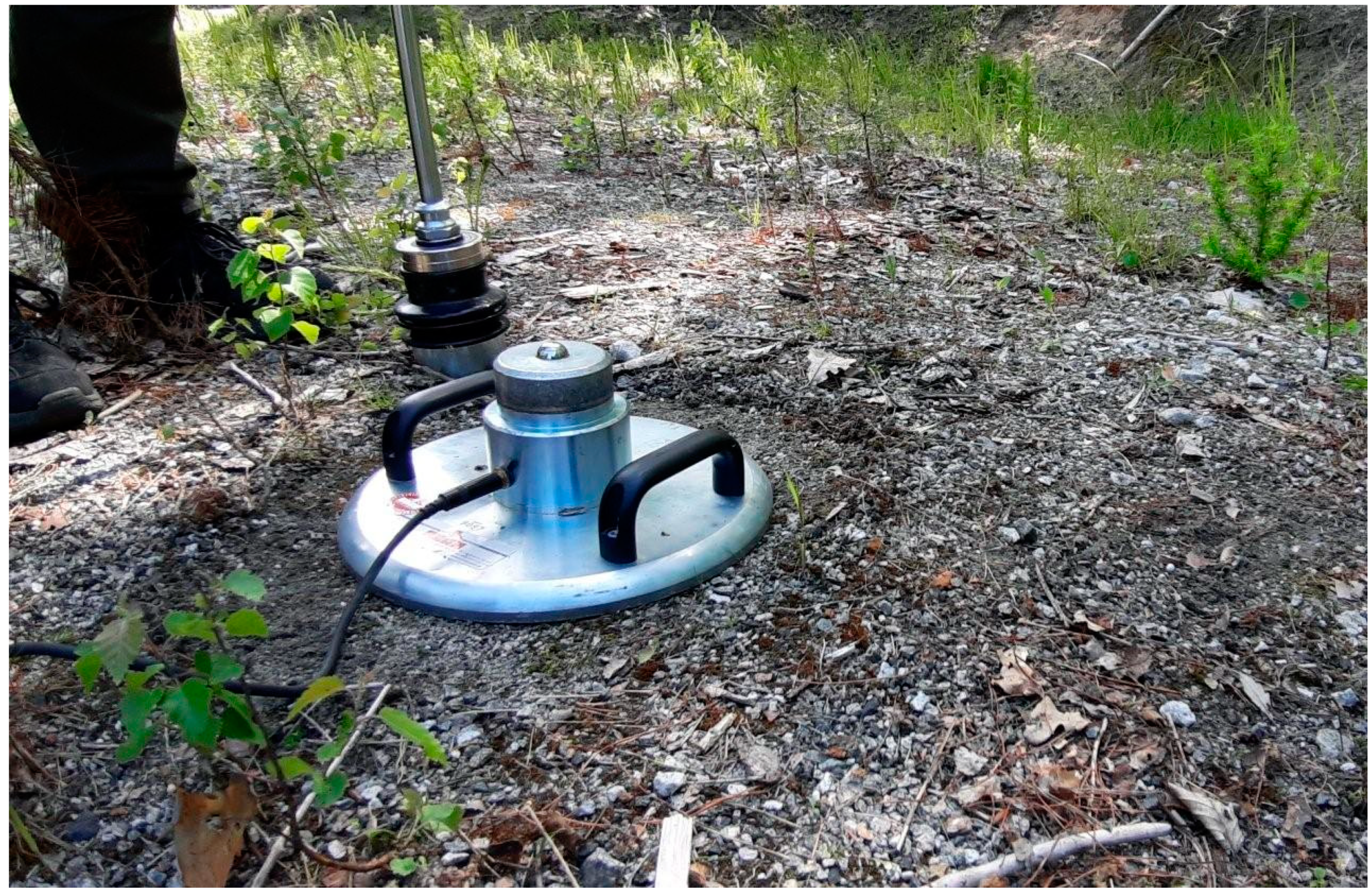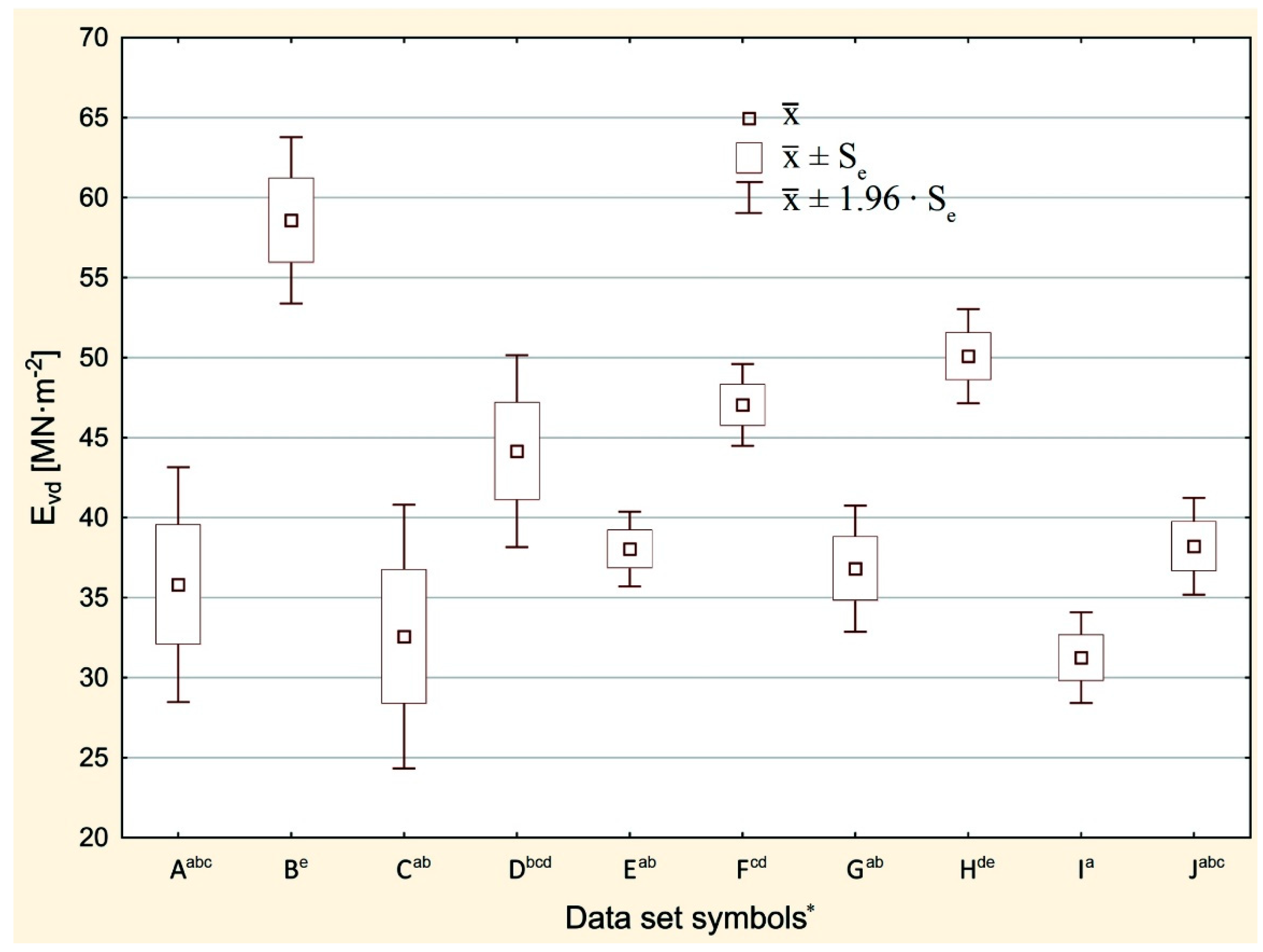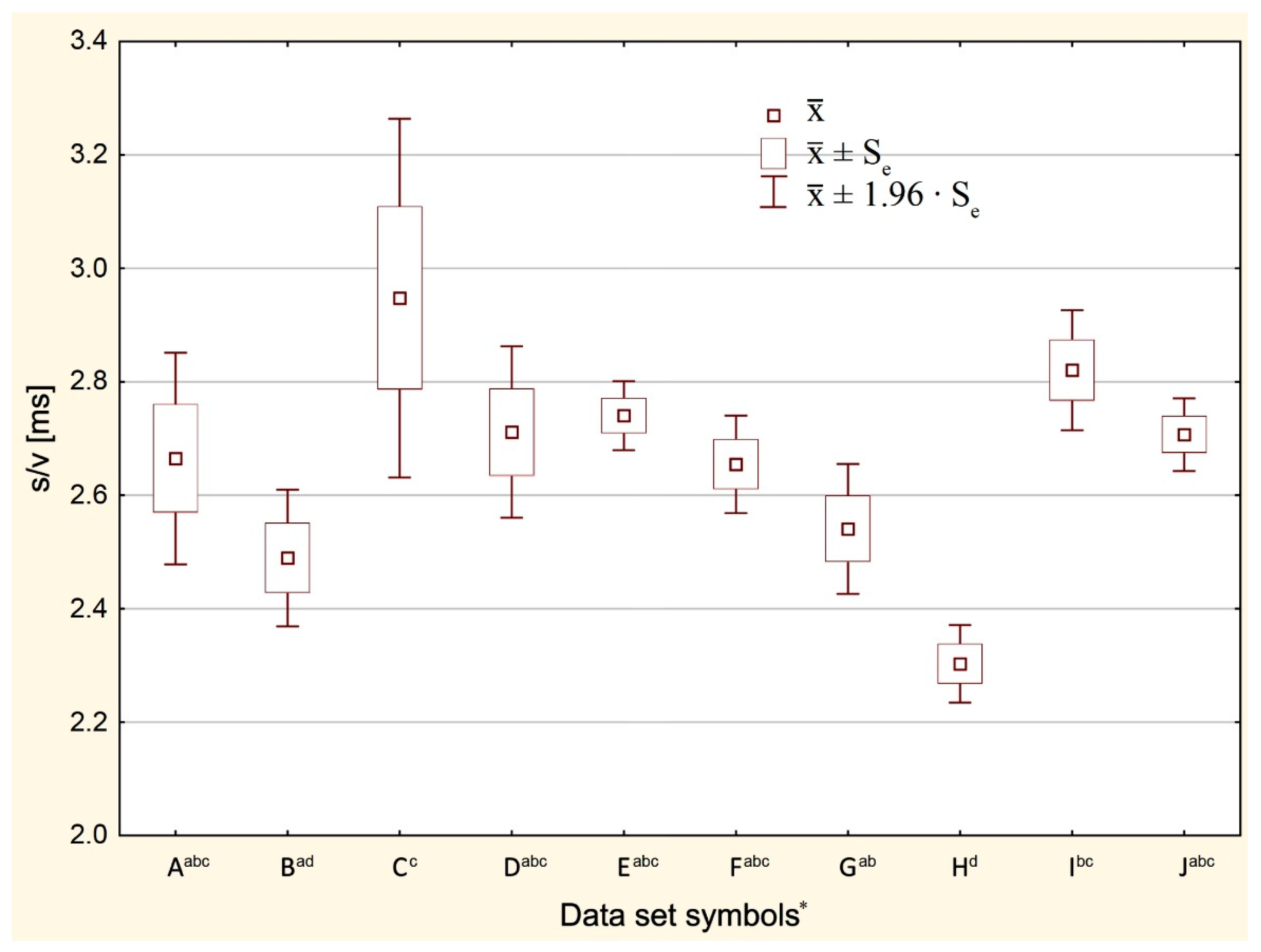The Influence of Vegetation Succession on Bearing Capacity of Forest Roads Made of Unbound Aggregates
Abstract
1. Introduction
2. Materials and Methods
3. Results
4. Discussion
5. Conclusions
- (1)
- The significant deterioration of bearing capacity parameters of the pavement caused by the developing vegetation succession on the surface indicates that systematic mowing of the surface (including the maneuvering, storage and passing areas) should be regarded as a standard and mandatory practice in order to preserve roads in forests.
- (2)
- Cutting off the vegetation close to the ground does not lead to the significant increase in bearing capacity parameters, which means that the owners/maintenance crew of the road should counteract any vegetation growth, and as a final measure eradicate it as soon as possible.
- (3)
- On the forest roads exploited less intensively, it is recommended to mechanically remove the organic matter that accumulates on the surface. This treatment will delay the growth of vegetation on the surface. Humus removal is easier and cheaper than mechanical removal of plants and safer when using herbicide compounds.
Author Contributions
Funding
Acknowledgments
Conflicts of Interest
References
- Trzciński, G.; Czerniak, A.; Grajewski, S. Funkcjonowanie infrastruktury komunikacyjnej obszarów leśnych. Infrastruct. Ecol. Rural Areas 2016, 2, 527–542. [Google Scholar] [CrossRef]
- Munro, R. Dealing with Bearing Capacity Problems on Low Volume Roads Constructed on Peat. ROADEX II Project. Scotland. 2004. Available online: http://www.roadex.org/wp-content/uploads/2014/01/2_5-Roads-on-Peat_l.pdf (accessed on 8 August 2020).
- Dzikowski, J.; Szarłowicz, A.; Burzyński, S.; Rajsman, M.; Satoła, J.; Wiązowski, Z. Drogi Leśne. Poradnik Techniczny; DGLP w Warszawie, OR-W LP: Warszawa-Bedoń, Poland, 2006; p. 136. [Google Scholar]
- Godlewski, D. Nawierzchnie Drogowe; Oficyna Wydaw. PW: Warszawa, Poland, 2011; p. 274. ISBN 978-83-7207-965-7. [Google Scholar]
- Trzciński, G.; Kozakiewicz, P.; Selwakowski, R. The technical aspects of using timber in the construction of forest roads. J. Water Land Dev. 2017, 34, 241–247. [Google Scholar] [CrossRef]
- Kozakiewicz, P.; Trzciński, G. Wood in the construction of forest roads on poor-bearing road subgrades. Forests 2020, 11, 138. [Google Scholar] [CrossRef]
- Ramesh, H.N.; Manoj Krishna, K.V.; Mamatha, H.V. Compaction and strength behavior of lime-coir fiber treated Black Cotton soil. Geomech. Eng. 2010, 2. [Google Scholar] [CrossRef]
- Subramani, T.; Udayakumar, D. Experimental study on stabilization of clay soil using coir fiber. IJAIEM 2016, 5, 192–204. [Google Scholar]
- Anandhamurugan, A.; Karuppasamy, K.; Jagan, S. Study on the stabilization of soil using coir fibers. JARBEST 2017, 3, 101–110. [Google Scholar]
- Muthu Lakshmi, S.; Sasikala, S.; Padmavathi, V.; Priya, S.; Saranya, V. Improvement of local subgrade soil for road construction by the use of coconut coir fiber. IJRET 2018, 5, 2873–2878. [Google Scholar]
- Raut, S.R.; Gadhawe, P.S.; Ingole, Y.U. Review on stabilization of soil using coconut coir fibre. IRJET 2020, 7, 1467–1469. [Google Scholar]
- Nita, P.; Graczyk, M. Ground and sward airfield pavements. Pr. Inst. Badaw. Dróg Most. 1998, 3–4, 45–62. [Google Scholar]
- Carr, W.W. A Handbook for Forest Roadside Erosion Control in British Columbia. Land Management Report No. 4. Province of British Columbia; Ministry of Forests, Information Service Branch: Victoria, BC, Canada, 1980.
- Forman, R.T.T.; Sperling, D.; Bissonette, J.; Clevenger, A.P.; Cutshall, C.; Dale, V.; Fahrig, L.; France, R.; Goldman, C.; Heanue, K.; et al. Road Ecology: Science and Solutions; Island Press: Washington, DC, USA, 2003. [Google Scholar]
- Dyrness, C.T. Grass-legume mixtures for erosion control along forest roads in western Oregon. J. Soil Water Conserv. 1975, 30, 169–173. [Google Scholar]
- Grace, J.M. Forest road sideslopes and soil conservation techniques. J. Soil Water Conrewatlon 2000, 65, 96–101. [Google Scholar]
- Grace, J.M. Effectiveness of vegetation in erosion control from forest road sideslopes. Transactions of the ASAE. Am. Soc. Agric. Eng. 2002, 45, 681–685. [Google Scholar] [CrossRef]
- Arnáez, J.; Larrea, V.; Ortigosa, L. Surface runoff and soil erosion on unpaved forest roads from rainfall simulation tests in northeastern Spain. Catena 2004, 57, 1–14. [Google Scholar] [CrossRef]
- Cao, C.; Chen, L.; Gao, W.; Chen, Y.; Yan, M. Impact of planting grass on terrene roads to avoid soil erosion. Landsc. Urban Plan. 2006, 78, 205–216. [Google Scholar] [CrossRef]
- Fu, B.; Newham, L.T.H.; Ramos-Scharrón, C.E. A review of surface erosion and sediment delivery models for unsealed roads. Environ. Model. Softw. 2010, 25, 1–14. [Google Scholar] [CrossRef]
- Akbarimehr, M.; Naghd, R. Reducing erosion from forest roads and skid trails by management practices. J. For. Sci. 2012, 58, 165–169. [Google Scholar] [CrossRef]
- Teramoto, Y.; Shimokawa, E.; Ezaki, T.; Chun, K.-W.; Kim, S.-W. Factors controlling sediment production from a yarding road and its temporal pattern in an abandoned clear-cut plantation forest in the Shirasu (pyroclastic flow deposits) area, Kagoshima Prefecture, Japan. For. Sci. Technol. 2015, 11, 54–60. [Google Scholar] [CrossRef]
- Morschel, J.; Fox, D.M.; Bruno, J.-F. Limiting sediment deposition on roadways: Topographic controls on vulnerable roads and cost analysis of planting grass buffer strips. Environ. Sci. Policy 2004, 7, 39–45. [Google Scholar] [CrossRef]
- Zemke, J.J. Runoff and soil erosion assessment on forest roads using a small scale rainfall simulator. Hydrology 2016, 3, 25. [Google Scholar] [CrossRef]
- Swanson, F.J.; Dyrness, C.T. Impact of clear-cutting and road construction on soil erosion by landslides in the western Cascade Range, Oregon. Geology 1975, 3, 393–396. [Google Scholar] [CrossRef]
- Dolidon, N.; Hofer, T.; Jansky, L.; Sidle, R. Watershed and forest management for landslide risk reduction. In Landslides–Disaster Risk Reduction; Sassa, K., Canuti, P., Eds.; Springer-Verlag: Berlin/Heidelberg, Germany, 2009; pp. 633–649. [Google Scholar]
- Rickli, C.; Graf, F. Effects of forests on shallow landslides–case studies in Switzerland. For. Snow Landsc. Res. 2009, 82, 33–44. [Google Scholar]
- Lee, J.-T.; Chu, M.-Y.; Lin, Y.-S.; Kung, K.-N.; Lin, W.-C.; Lee, M.-J. Root traits and biomechanical properties of three tropical pioneer tree species for forest restoration in landslide areas. Forests 2020, 11, 179. [Google Scholar] [CrossRef]
- Kopinga, J. Aspects of the damage to asphalt road pavings caused by roots. In The Landscape below Ground. Proceedings of an International Workshop on Tree Root Development in Urban Soils; Watson, G., Neely, D., Eds.; International Society of Arboriculture: Champaign, IL, USA, 1994; pp. 165–178. [Google Scholar]
- Randrup, T.B.; McPherson, E.G.; Costello, L.R. A review of tree root conflicts with sidewalks, curbs and roads. Urban Ecosyst. 2001, 5, 209–225. [Google Scholar] [CrossRef]
- Helliwell, D.R. The extent of tree roots. Arboric. J. 1986, 10, 341–347. [Google Scholar] [CrossRef]
- Cutler, D.F. Interactions between tree roots and construction work. Arboric. J. 1993, 17, 47–55. [Google Scholar] [CrossRef]
- Kristoffersen, P. Trees in road foundation materials. Arboric. J. 1999, 23, 57–76. [Google Scholar] [CrossRef]
- Papierowska, E.; Szatyłowicz, J.; Ruta, M.; Łachacz, A.; Gnatowskia, T.; Stańczyk, T. Water repellency of soils on unpaved roads in coniferous forests. Catena 2020, 195, 104784. [Google Scholar] [CrossRef]
- Boston, K.; Leshchinsky, B.; Kemp, E.; Wortman, R. The use of a rotary asphalt broom to groom aggregate forest roads. Croat. J. For. Eng. 2017, 38, 119–126. [Google Scholar]
- Leśne, D. Poradnik Techniczny. Dyrekcja Generalna Lasów Państwowych, Warszawa–Bedoń. 2006. Available online: https://bip.lasy.gov.pl/pl/bip/px_dg~rdlp_torun~nadl_torun~drogi_lesne.pdf (accessed on 10 October 2020).
- Rolla, S. Badania Materiałów i Nawierzchni Drogowych; WKŁ: Warszawa, Poland, 1985. [Google Scholar]
- Instrukcja Obsługi Lekkiego Ugięciomierza Dynamicznego ZFG 3000; Maszynopis, Merazet: Poznań, Poland, 2012.
- EN ISO 10319:2015 Geosynthetics. Wide-width Tensile Test (ISO 10319:2015); International Organization for Standardization, Technical Committee ISO/TC 221 Geosynthetics: Geneva, Switzerland, 2015.
- Łupieżowiec, M. Wpływ sztywnych geomateracy na odkształcalność podłoża gruntowego pod nawierzchnie drogowe. Czas. Tech. Środowisko 2012, 109, 53–65. [Google Scholar]
- Grajewski, S.M. Functionality of Forest Fire Roads in View of Requirements of Modern Fire Engines and Pumper Trucks and Currently Used Forest Firefighting Tactics and Technologies; Rozprawy Naukowe: Uniwersytet Przyrodniczy w Poznaniu: Poznań, Poland, 2019. [Google Scholar]
- PN-S-96023:1984 Konstrukcje Drogowe. Podbudowa i Nawierzchnia z Tłucznia Kamiennego; Polski Komitet Normalizacji Miar i Jakości: Warszawa, Poland, 1984.
- OST D-05.02.01. Nawierzchnia Tłuczniowa; GDDP: Warszawa, Poland, 1998.
- Kamiński, B. Badania techniczne dróg leśnych. In Nowoczesne Technologie Budowy Dróg, Mostów i Przepustów Leśnych; Jodłowski, K., Czerniak, A., Eds.; Postępy Techniki w Leśnictwie: Warszawa, Poland, 2012; Volume 119, pp. 47–51. [Google Scholar]
- Maślakowski, M.; Bartnik, G.; Kowalczyk, S. Wpływ geosyntetyków na dobór metody pomiaru odkształcenia podłoża. Bud. Inżynieria Środowiska 2013, 4, 281–286. [Google Scholar]
- Bartnik, G. Zastosowanie Lekkiej Płyty Dynamicznej do Oceny Jakości Zagęszczenia Warstw Kruszywa Łamanego na Podłożu Gruntowym Wzmocnionym Geosyntetykiem; Maszyn. Rozpr. Dokt. Wydział Inżynierii Lądowej, Politechnika Warszawska: Warszawa, Poland, 2015. [Google Scholar]
- Bartnik, G.; Sulewska, M.J. Zastosowanie lekkiej płyty dynamicznej do badania gruntów zbrojonych. Inżynieria Morska Geotech. 2015, 3, 280–285. [Google Scholar]
- Haas, R.; Wall, J.; Carroll, R.G. Geogrid reinforcement of granular bases in flexible pavements. Transp. Res. Rec. 1988, 1188, 19–27. [Google Scholar]
- Kwon, J.; Tutumluer, E. Geogrid base reinforcement with aggregate interlock and modeling of associated stiffness enhancement in mechanistic pavement analysis. Transp. Res. Rec. J. Transp. Res. Board 2009, 2116, 85–95. [Google Scholar] [CrossRef]
- Krarup, J. Bearing Capacity and Water. Part 3: Measured Pavement Performance. Danish Road Institute Note, 253; Danish Road Institute. Road Directorate: Roskilde, Denmark, 1995. [Google Scholar]
- Charlier, R.; Hornych, P.; Srsen, M.; Hermansson, A.; Bjarnason, G.; Erlingsson, S.; Pavsic, P. Water influence on bearing capacity and pavement performance: Field observations. In Water in Road Structures; Movement, Drainage and Effects; Dawson, A., Ed.; Springer: Berlin/Heidelberg, Germany, 2009. [Google Scholar]
- Laloui, L.; Charlier, R.; Chazallon, C.; Erlingsson, S.; Hornych, P.; Pavsic, P.; Srsen, M. Water influence on mechanical behaviour of pavements: Constitutive modelling. In Water in Road Structures; Movement, Drainage and Effects; Dawson, A., Ed.; Springer: Berlin/Heidelberg, Germany, 2009; pp. 193–216. [Google Scholar]
- Grajewski, S.M. Influence of pavement moisture content on the load-bearing capacity of forest road. Infrastruct. Ecol. Rural Areas 2016, 2, 1451–1462. [Google Scholar]
- Sofo, A.; Elshafie, H.S.; Camele, I. Structural and functional organization of the root system: A comparative study on five plant species. Plants 2020, 9, 1338. [Google Scholar] [CrossRef]





| Road Section Number | Element | Description |
|---|---|---|
| 1 | Pavement, shoulder, passing place and storage area | The width of the road with a left-side crossfall 4%—3.5 m; the width of shoulders reinforced with natural aggregate and crossfall 6%—2 × 0.75 m; passing places 3.0 m wide and 23.0 m long with slants in 1:7 ratio; storage area 10.0 m wide and 40.0 m long. |
| Wearing course | 0–12 cm mechanically stabilised crushed stone aggregate 0/31.5 mm with stony silt coating 0/8 mm. | |
| Base course | 12–27 cm mechanically stabilised crushed stone aggregate 0/63 mm. | |
| Subbase course (frost resistant layer) | 27–42 cm mechanically stabilised natural fine aggregate—medium sand (MSa). | |
| Soil subgrade | 43–250 cm sandy clay (saCl). | |
| 2 | Pavement, shoulder, storage area | The width of the road with two-way crossfall 4%—3.5 m; the width of shoulders reinforced with natural aggregate with crossfall 6%—2 × 0.5 m; storage area 10.0 m wide and 40.0 m long. |
| Wearing course | 0–12 cm mechanically stabilised crushed stone aggregate 0/31.5 mm with stony silt coating 0/8 mm. | |
| Base course | 12–27 cm mechanically stabilised crushed stone aggregate 0/63mm. Biaxial geogrid (MD/CMD acc. [39] 33/33 (−3) kN/m) with 30 × 30 mm aperture. | |
| Subbase course (frost resistant layer) | 27–42 cm mechanically stabilised natural fine aggregate—medium sand (MSa). | |
| Soil subgrade | 42–250 cm fine sand (FSa) intercalated with clayey sand (FSaclSa). |
| Section No. | Testing Season | The Data Set Specification | Assigned Data Set Symbol * |
|---|---|---|---|
| 1 | Spring 2019 | The results of bearing capacity measurements taken in the places covered with vegetation | A |
| 1 | Spring 2019 | The results of bearing capacity measurements taken in the places deprived of vegetation, located in the direct vicinity of spots from set “A” sites (reference point) | B |
| 2 | Spring 2019 | The results of bearing capacity measurements taken in the places covered with vegetation | C |
| 2 | Spring 2019 | The results of bearing capacity measurements taken in the places deprived of vegetation, located in the direct vicinity of spots from set “C” sites (reference point) | D |
| 1 | Spring 2020 | No results due to a technical problem | – |
| 1 | Spring 2020 | No results due to a technical problem | – |
| 2 | Spring 2020 | The results of bearing capacity measurements taken in the places with vegetation after its mechanical eradication (mowing to the level of the road pavement) | E |
| 2 | Spring 2020 | The results of bearing capacity measurements taken in the sites deprived of vegetation in the direct vicinity of spots from set “E” (reference point) | F |
| 1 | Autumn 2020 | Results of bearing capacity measurements taken in the places with vegetation after its mechanical eradication (mowing to the level of the road pavement) | G |
| 1 | Autumn 2020 | The results of bearing capacity measurements taken in the sites deprived of vegetation in the direct vicinity of spots from set “G” | H |
| 2 | Autumn 2020 | The results of bearing capacity measurements taken in the places with vegetation after its mechanical eradication (mowing to the level of the road pavement) | I |
| 2 | Autumn 2020 | The results of bearing capacity measurements taken in sites deprived of vegetation in the direct vicinity of spots from set “I” | J |
| Road Section Number (Sn) | Testing Season | Data Set Symbol | Type of Testing Place | Plant Species | Species Structure (Percentage Share in the Study Segment) |
|---|---|---|---|---|---|
| 1 | Spring 2019 and spring 2020 | A, B | Passing place | black locust Robinia pseudoacacia L. | single |
| common aspen Populus tremula L. and grey poplar Populus canescens | single | ||||
| eared willow Salix aurita L. | single | ||||
| Scots pine Pinus sylvestris L. | 20% | ||||
| silver birch Betula pendula Roth | 40% | ||||
| wood small-reed Calamagrostis epigejos (L.) Roth. | 20% | ||||
| Road surface coverage degree | 80% | ||||
| A, B | Storage area | common aspen Populus tremula L. and grey poplar Populus canescens | single | ||
| Scots pine Pinus sylvestris L. | 10% | ||||
| silver birch Betula pendula Roth | 50% | ||||
| white clover Trifolium repens L. | single | ||||
| wood small-reed Calamagrostis epigejos (L.) Roth | 20% | ||||
| Road surface coverage degree | 80% | ||||
| Autumn 2020 | G, H | Storage area | annual meadow grass Poa annua L. | single | |
| black locust Robinia pseudoacacia L. | single | ||||
| broadleaf plantain Plantago major L. | single | ||||
| Canadian hawkweed Hieracium umbellatum L. | single | ||||
| chamomile Matricaria chamomilla L. | single | ||||
| charlock mustard Sinapis arvensis L. | single | ||||
| coltsfoot Tussilago farfara L. | single | ||||
| common aspen Populus tremula L. and grey poplar Populus canescens | single | ||||
| common hemp-nettle Galeopsis tetrahit L. | single | ||||
| common knotgrass Polygonum aviculare L. | single | ||||
| common mugwort Artemisia vulgaris L. | single | ||||
| common tansy Tanacetum vulgare L. | single | ||||
| creeping thistle Cirsium arvense (L.) Scop | single | ||||
| dandelion Taraxacum officinale (L.) Weber ex F.H. Wigg | single | ||||
| denseflower mullein Verbascum densiflorum Bertol. | single | ||||
| eared willow Salix aurita L. | single | ||||
| European black nightshade Solanum nigrum L. | single | ||||
| European goldenrod Solidago virgaurea L. | single | ||||
| field pansy Viola arvensis Murr. | single | ||||
| gallant soldier Galinsoga parviflora Cav. | single | ||||
| goat willow Salix caprea L. | single | ||||
| green amaranth Amaranthus hybridus L. | single | ||||
| horseweed Erigeron canadensis (L.) Cronquist | 10% | ||||
| lamb’s quarters Chenopodium album L. | single | ||||
| ribwort plantain Plantago lanceolata L. | single | ||||
| Scots pine Pinus sylvestris L. | 10% | ||||
| silver birch Betula pendula Roth | 50% | ||||
| small balsam Impatiens parviflora DC. | single | ||||
| white clover Trifolium repens L. | single | ||||
| wood small-reed Calamagrostis epigejos (L.) Roth | 20% | ||||
| Road surface coverage degree | 90% | ||||
| 2 | Spring 2019 and spring 2020 | C, D, E, F | Storage area | common aspen Populus tremula L. and grey poplar Populus canescens | single |
| eared willow Salix aurita L. | single | ||||
| European larch Larix decidua Mill. | single | ||||
| large-leaved lupine Lupinus polyphyllus L. | single | ||||
| Scots pine Pinus sylvestris L. | 10% | ||||
| silver birch Betula pendula Roth | 50% | ||||
| viper’s bugloss Echium vulgare L. | single | ||||
| white clover Trifolium repens L. | single | ||||
| wood small-reed Calamagrostis epigejos (L.) Roth | 20% | ||||
| Road surface coverage degree | 80% | ||||
| Autumn 2020 | I, J | annual meadow grass Poa annua L. | single | ||
| broadleaf plantain Plantago major L. | single | ||||
| Canadian hawkweed Hieracium umbellatum L. | single | ||||
| coltsfoot Tussilago farfara L. | single | ||||
| common aspen Populus tremula L. and grey poplar Populus canescens | single | ||||
| common bent Agrostis capillaris L. | single | ||||
| dandelion Taraxacum officinale (L.) Weber ex F.H. Wigg | single | ||||
| eared willow Salix aurita L. | single | ||||
| European larch Larix decidua Mill. | single | ||||
| goat willow Salix caprea L. | single | ||||
| hare’s-foot clover Trifolium arvense L. | single | ||||
| horseweed Erigeron canadensis (L.) Cronquist | single | ||||
| Scots pine Pinus sylvestris L. | 10% | ||||
| silver birch Betula pendula Roth | 60% | ||||
| wood small-reed Calamagrostis epigejos (L.) Roth | 20% | ||||
| wormwood Artemisia absinthium L. | single | ||||
| Road surface coverage degree | 90% |
| DSS | N | Evd [MN·m−2] | s/v [ms] | ||||||||||
|---|---|---|---|---|---|---|---|---|---|---|---|---|---|
| * | xmin | xmax | SD | Se | zp [%] | * | xmin | xmax | SD | Se | zp [%] | ||
| 1 | 2 | 3 | 4 | 5 | 6 | 7 | 8 | 9 | 10 | 11 | 12 | 13 | 14 |
| A | 11 | 35.80 abc | 16.27 | 50.33 | 12.42 | 2.53 | 35 | 2.665 abc | 2.344 | 3.311 | 0.316 | 0.073 | 12 |
| B | 11 | 58.58 e | 47.07 | 72.97 | 8.79 | 2.53 | 15 | 2.489 ad | 2.192 | 2.828 | 0.204 | 0.073 | 8 |
| C | 10 | 32.56 ab | 15.73 | 49.12 | 13.28 | 2.65 | 41 | 2.948 c | 2.366 | 4.130 | 0.510 | 0.077 | 17 |
| D | 10 | 44.16 bcd | 26.74 | 60.00 | 9.68 | 2.65 | 22 | 2.712 abc | 2.345 | 3.089 | 0.244 | 0.077 | 9 |
| E | 20 | 38.03 ab | 28.70 | 47.67 | 5.33 | 1.88 | 14 | 2.740 abc | 2.545 | 3.006 | 0.139 | 0.054 | 5 |
| F | 20 | 47.04 cd | 38.46 | 57.99 | 5.84 | 1.88 | 12 | 2.655 abc | 2.367 | 2.937 | 0.196 | 0.054 | 7 |
| G | 20 | 36.81 ab | 16.90 | 54.22 | 10.05 | 1.68 | 27 | 2.541 ab | 2.185 | 3.428 | 0.292 | 0.049 | 11 |
| H | 20 | 50.09 de | 26.66 | 65.98 | 7.52 | 1.68 | 15 | 2.303 d | 2.07 | 2.75 | 0.17 | 0.049 | 8 |
| I | 13 | 31.24 a | 21.27 | 42.29 | 5.22 | 2.33 | 17 | 2.821 bc | 2.52 | 3.21 | 0.19 | 0.068 | 7 |
| J | 13 | 38.21 abc | 33.78 | 48.18 | 5.56 | 2.33 | 15 | 2.707 abc | 2.51 | 2.81 | 0.12 | 0.068 | 4 |
Publisher’s Note: MDPI stays neutral with regard to jurisdictional claims in published maps and institutional affiliations. |
© 2020 by the authors. Licensee MDPI, Basel, Switzerland. This article is an open access article distributed under the terms and conditions of the Creative Commons Attribution (CC BY) license (http://creativecommons.org/licenses/by/4.0/).
Share and Cite
Grajewski, S.M.; Czerniak, A.; Kurowska, E.E. The Influence of Vegetation Succession on Bearing Capacity of Forest Roads Made of Unbound Aggregates. Forests 2020, 11, 1137. https://doi.org/10.3390/f11111137
Grajewski SM, Czerniak A, Kurowska EE. The Influence of Vegetation Succession on Bearing Capacity of Forest Roads Made of Unbound Aggregates. Forests. 2020; 11(11):1137. https://doi.org/10.3390/f11111137
Chicago/Turabian StyleGrajewski, Sylwester M., Andrzej Czerniak, and Ewa E. Kurowska. 2020. "The Influence of Vegetation Succession on Bearing Capacity of Forest Roads Made of Unbound Aggregates" Forests 11, no. 11: 1137. https://doi.org/10.3390/f11111137
APA StyleGrajewski, S. M., Czerniak, A., & Kurowska, E. E. (2020). The Influence of Vegetation Succession on Bearing Capacity of Forest Roads Made of Unbound Aggregates. Forests, 11(11), 1137. https://doi.org/10.3390/f11111137





